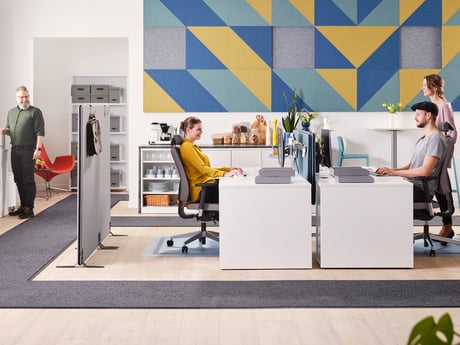How to prevent your open office from harming productivity

Open plan offices offer many benefits: they offer a more effective use of available space, create a flatter structure across the business and allow for more flexible and modern office design. However, it is important to ensure that this doesn’t come at the expense of productivity. Working in an open office can affect your focus and increase stress levels due to the high noise levels and lack of privacy. Ironically, a 2018 Harvard Business School study found that open-plan offices actually lead to a 70% decrease in face-to-face communication by causing people to socially withdraw from their co-workers.
Many businesses also fail to take into account different personality types: while extroverts often like to work in collaborative spaces where they can communicate with colleagues and discuss ideas, introverts usually prefer quiet spaces where they can be left to concentrate.
We outline some of the most important factors to consider and how to address them to ensure that your open-plan office is a harmonious and effective working space for all employees.
Acoustics
Generally considered to be the biggest problem with open-plan offices, high noise levels reduce concentration and distract people from their work. According to a 2017 Sodexo study, 51% of workers claim that reducing unnecessary noise is the single most important factor to improving their effectiveness at work. There are many simple ways to reduce the background noise in an open workplace without having to make major changes to the office layout. Acoustic solutions such as desk screens, acoustic wall panels and ceiling hanging panels are designed to reduce overall noise levels by absorbing sound reverberations. Sound-masking systems and acoustic panels are relatively inexpensive solutions that can be retrofitted into any office space to improve the soundscape.
Privacy
Another common complaint about open offices is the lack of privacy they afford; in many respects this goes hand in hand with the issue of noise. Many people prefer to work silently and alone to be at their most productive; this can also depend on the type of role you’re in and the task you’re currently trying to complete. At the most basic level, desk screens provide a barrier between each desk so that each employee has their own space and is not constantly overlooked. A more effective solution is to provide plenty of quiet private spaces for workers to use as and when they want.
An acoustic booth or pod is an affordable and functional way to create a secluded space that can become a temporary private zone. Not only does it offer a space that is physically separate from the rest of the office, but it also muffles sound, providing conversational privacy so it is possible to have a conversation with a colleague or take a phone call without being overheard.
The activity-based workplace
An effective way to address the problem of an open workspace is to divide the office into different zones. An activity-based workplace (ABW) provides a mixture of open, semi-private and private spaces in one office to cater for the needs of all the staff who work there. Use tall furniture and acoustic screens to build "rooms" within the room to separate noisier areas from allocated quiet spaces. Consider how often you use meeting rooms and whether any of those could be turned into a library-style silent working space.
By offering diverse work environments in the office, you support different personality types as well as different roles in the company, increasing productivity and employee satisfaction.


